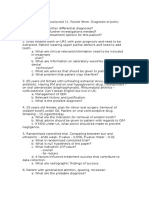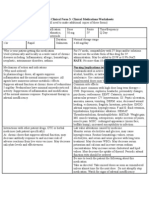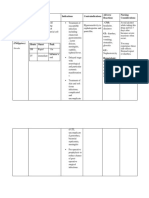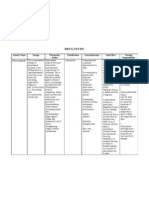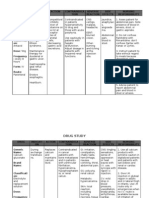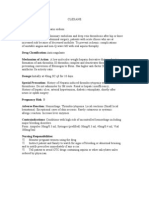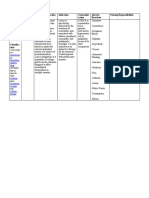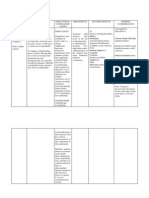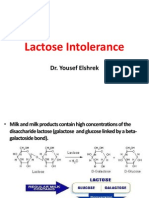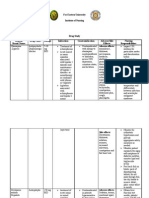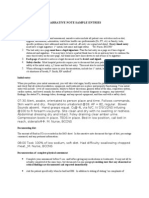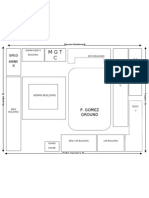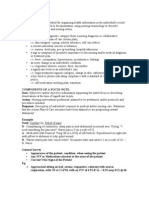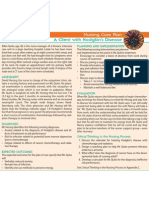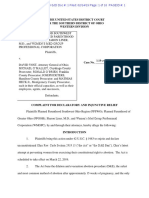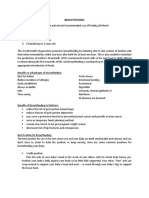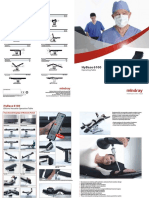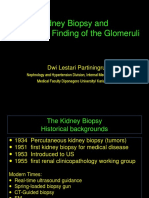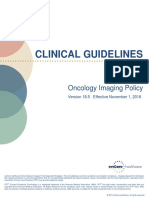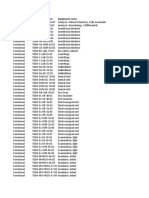Drug Study of Ceftriaxone & Rowatinex
Drug Study of Ceftriaxone & Rowatinex
Uploaded by
Lorina Lynne ApelacioCopyright:
Available Formats
Drug Study of Ceftriaxone & Rowatinex
Drug Study of Ceftriaxone & Rowatinex
Uploaded by
Lorina Lynne ApelacioOriginal Description:
Copyright
Available Formats
Share this document
Did you find this document useful?
Is this content inappropriate?
Copyright:
Available Formats
Drug Study of Ceftriaxone & Rowatinex
Drug Study of Ceftriaxone & Rowatinex
Uploaded by
Lorina Lynne ApelacioCopyright:
Available Formats
Louielyn V.
Paragas Drug Study
Generic Name Camphene Brand Name Rowatinex Dosage
BSN 301 Group 3
1 tab TID
Contraindicati ons st Urolithiasis, 1 trimester of nephrolithiasis pregnancy , cystitis, renal colic, UTI,postop prophylaxis of calcul Oral (cefuroxime axetil) Pharyngitis, tonsillitis caused by Streptococcus pyogenes Otitis media caused by Streptococcus pneumonia, S. pyogenes, Haemophilus influenza, Moraxella catarrhalis Acute bacterial maxillary sinusitis caused by S. Allergy to cephalosporins or penicillin.
Indications
Side Effects No side effects have been reported
Cefuroxime
Ceftin, Zinacef
750 mg IV q 8 (-)ANST
Headache, dizziness, lethargy, paresthesias, nausea, vomiting, diarrhea, anorexia, abdominal pain, flatulence, pseudomembra nous colitis, hepatotoxixity, nephrotoxicity, bone marrow depression, pain, abscess at injection site, phlebitis, inflammation at IV site, superinfection,
Nursing Responsibility Liquid intake should be increased during therapy. Store at temperatures not exceeding 30 degrees Celsius. Culture infection site, and arrange for sensitivity tests before and during therapy if expected response is not seen give oral drug with food to decrease GI upset and enhance absorption. give oral tablets to children who can swallow tablets, crushing the drug results to a bitter, unpleasant taste. Use solution for children who cant
pneumoniae, H. influenzae Lower respiratory Infections caused by by S. pneumoniae, H. influenzae, Haemophilus parainfluenza e UTis caused by Eschiricia coli, Klebsiella pneumoniae Uncomplicat ed gonorrhoea (urethral and endocervical) Skin and skin structure infections including impetigo caused by Streptococcus aureus, S. pyogenes Treatment of early Lyme disease Parenteral (Cefuroxime sodium)
disulfram like reaction with alcohol.
swallow tablets. Have vitamin K available in case hypoprothrombin emia occurs. Discontinue if hypersensitivity reaction occurs.
Lower respiratory infections, dermatologic infections, UTI, uncomplicate d and disseminated gonorrhea, septicimia, Meningitis, Bone and joint infections, Perioperative prophylaxis, Treatment of acute bacterial maxillary sinusitis in patients 3mo12yr Ceftriaxone sodium Rocephin 2gm IV now then 0.0 ANST (-) Lower respiratory infections, acute bacterial otitis media, UTI, gonorrhoea, PID, Skin and skin structure infections, septicaemia, bone and joint Allergy to caphalosporins or penicillin Headache, dizziness, lethargy, paresthesias, nausea, vomiting, diarrhea, anorexia, abdominal pain, flatulence, pseudomembra nous colitis, Culture infection site, and arrange for sensitivity tests before and during therapy if expected response is not seen Reconstitute for IM use with sterile water for injection, 0.9%
infections, meningitis, perioperative prophylaxis for patients undergoing coronary artery bypass surgery and in contaminated or potentially contaminated surgical procedures.
hepatotoxixity, nephrotoxicity, bone marrow depression, pain, abscess at injection site, phlebitis, inflammation at IV site, superinfection, disulfram like reaction with alcohol.
sodium chloride solution, 5% dextrose solution, bacteriostatic water with 0.9% benzyl alcohol, or 1% lidocaine solution (without epinephrine); inject deeply into a large muscle group. Check manufacturers inserts for specific details. Stability of reconstituted and diluted solution depends on diluents, concentration and type of container. Protect drug from light Do not mix ceftriaxone with any other antimicrobial drug. Monitor ceftriaxone blood levels in patients with severe renal impairments and in patients with renal and hepatic
impairment. Have vitamin K available in case hypoprothrombin emia occurs. Discontinue if hypersensitivity reaction occurs.
You might also like
- MFDS Questions ImpDocument8 pagesMFDS Questions ImpalkaNo ratings yet
- Advantages and Disadvantages For Nurses of Using Social MediaDocument3 pagesAdvantages and Disadvantages For Nurses of Using Social Mediajoana marie reyesNo ratings yet
- PrednisoloneDocument2 pagesPrednisoloneKatie McPeekNo ratings yet
- Drug Study QIDocument8 pagesDrug Study QImaeDonitaNo ratings yet
- Drug StudyDocument2 pagesDrug StudyLee JennyNo ratings yet
- Drug StudyDocument7 pagesDrug StudyHerwincayeNo ratings yet
- Drug Study of ChloramphenicolDocument3 pagesDrug Study of Chloramphenicolcasimir1128No ratings yet
- Calcium Gluconate Drug SummDocument1 pageCalcium Gluconate Drug SummAminah Yue100% (1)
- XtendaDocument2 pagesXtendaAlexis CoronadoNo ratings yet
- Drug Study Drug Name Mechanism of Action Dosage Indication Contraindication Side Effects Nursing InterventionsDocument5 pagesDrug Study Drug Name Mechanism of Action Dosage Indication Contraindication Side Effects Nursing InterventionsYvonne AgathaNo ratings yet
- ItoprideDocument2 pagesItoprideLesValenzuelaNo ratings yet
- Itopride HCL Pynetic 50mg TabDocument2 pagesItopride HCL Pynetic 50mg TabAusaf AhmadNo ratings yet
- Drug Study AmbroxolDocument2 pagesDrug Study AmbroxoledemNo ratings yet
- Duodart: Dutasteride-Tamsulosin HydrochlorideDocument23 pagesDuodart: Dutasteride-Tamsulosin HydrochlorideYessy AndikaNo ratings yet
- Calcium Gluconate Drug StudyDocument4 pagesCalcium Gluconate Drug StudyAngelou Joefred CongresoNo ratings yet
- Veklury (Remdesivir) Dosing, Indications, Interactions, Adverse Effects, and MoreDocument4 pagesVeklury (Remdesivir) Dosing, Indications, Interactions, Adverse Effects, and MoreRex ChanNo ratings yet
- CELECOXIBDocument2 pagesCELECOXIBElaine Iris AbastaNo ratings yet
- F&E Drug StudyDocument2 pagesF&E Drug Studychelle_asenjoNo ratings yet
- TergecefDocument2 pagesTergecefianecunar100% (3)
- Drug Study: San Francisco St. Butuan City 8600, Region XIII Caraga, PhilippinesDocument2 pagesDrug Study: San Francisco St. Butuan City 8600, Region XIII Caraga, PhilippinesNikki Caryl ZafraNo ratings yet
- Drug StudiesDocument16 pagesDrug Studiesvitcloud23100% (2)
- AlgesiaDocument2 pagesAlgesiaNanen Camince100% (1)
- Drug Study Duavent.Document1 pageDrug Study Duavent.Clariss AlotaNo ratings yet
- Humulin R, Novolin RDocument2 pagesHumulin R, Novolin RSheri490100% (2)
- College of Nursing: Rifadin RifampinDocument4 pagesCollege of Nursing: Rifadin RifampinAnika PleñosNo ratings yet
- Generic Name:: ClassificationsDocument4 pagesGeneric Name:: ClassificationsbillyktoubattsNo ratings yet
- Drug Study LevofloxacinDocument2 pagesDrug Study LevofloxacinDannah BulliandayNo ratings yet
- Drug StudyDocument3 pagesDrug StudyMarychen Cabunas100% (1)
- F. Case Study Thesis-Drug Study (Revised)Document5 pagesF. Case Study Thesis-Drug Study (Revised)Lopirts NiganiNo ratings yet
- AmpicillinDocument2 pagesAmpicillinMar OrdanzaNo ratings yet
- Drug Study AzithromycinDocument2 pagesDrug Study AzithromycinYamete KudasaiNo ratings yet
- BisoprololDocument2 pagesBisoprololNovi YulianaNo ratings yet
- CombiventDocument1 pageCombiventDherick Rosas0% (1)
- DiazepamDocument1 pageDiazepamStephanie PeNo ratings yet
- UnasynDocument1 pageUnasynrachieeeNo ratings yet
- Drug Study (Extra) !Document1 pageDrug Study (Extra) !Anonymous 75TDy2yNo ratings yet
- Drug Study InsulinDocument2 pagesDrug Study InsulinGrant Kenneth Dumo AmigableNo ratings yet
- Drug Study of CiprofloxacinDocument3 pagesDrug Study of CiprofloxacinZyra MendozaNo ratings yet
- Drug Monograph XareltoDocument2 pagesDrug Monograph XareltoBenNo ratings yet
- Drug Study: Diphenhydramine IVDocument6 pagesDrug Study: Diphenhydramine IVMarson RosaritoNo ratings yet
- Drug Study Gastro EnteristisDocument2 pagesDrug Study Gastro Enteristisimeejen100% (1)
- Drug Study of Mannitol RMCDocument1 pageDrug Study of Mannitol RMCAdrian Ardamil0% (1)
- Drug Study FinalDocument6 pagesDrug Study FinalJade HemmingsNo ratings yet
- ApidraDocument4 pagesApidraRobert Ivan AgujarNo ratings yet
- Drug Study 2Document8 pagesDrug Study 2rey_tengNo ratings yet
- Felodipine CefuroximeDocument3 pagesFelodipine CefuroximecotyboyNo ratings yet
- Drug StudyDocument7 pagesDrug StudyMae Navidas DigdiganNo ratings yet
- Nifedipine and Prednisone Drug StudyDocument5 pagesNifedipine and Prednisone Drug StudyAllyne GavinoNo ratings yet
- Nacl Drug StudyDocument1 pageNacl Drug StudydyndzNo ratings yet
- Insulin NPHDocument1 pageInsulin NPHChristopher LeeNo ratings yet
- AlprazolamDocument3 pagesAlprazolamapi-3797941100% (1)
- CelecoxibDocument2 pagesCelecoxibHazelSteffiNo ratings yet
- MG Drug StudyDocument3 pagesMG Drug StudySandra MedinaNo ratings yet
- Lyrica (Pregabalin)Document2 pagesLyrica (Pregabalin)Laromac RolandNo ratings yet
- Ascorbic AcidDocument2 pagesAscorbic AcidJaymark Lambino50% (2)
- CombiventDocument1 pageCombiventleroux2890No ratings yet
- CoversylDocument3 pagesCoversylianecunarNo ratings yet
- The Ride of Your Life: What I Learned about God, Love, and Adventure by Teaching My Son to Ride a BikeFrom EverandThe Ride of Your Life: What I Learned about God, Love, and Adventure by Teaching My Son to Ride a BikeRating: 4.5 out of 5 stars4.5/5 (2)
- Drug StudyDocument8 pagesDrug StudyMaAngelica Tresha RaonNo ratings yet
- Drug StudyDocument6 pagesDrug StudyRyan BancoloNo ratings yet
- Azithromycin (1 G Azithromycin in Monodosis)Document2 pagesAzithromycin (1 G Azithromycin in Monodosis)inah krizia lagueNo ratings yet
- Antispasmodic Anticholinergic: Drug NameDocument13 pagesAntispasmodic Anticholinergic: Drug NameAngela Rose BaliteNo ratings yet
- Drug Study of Antidiabetic DrugsDocument6 pagesDrug Study of Antidiabetic DrugsLorina Lynne ApelacioNo ratings yet
- Lactose IntoleranceDocument20 pagesLactose IntoleranceLorina Lynne ApelacioNo ratings yet
- Psych Drug StudyDocument5 pagesPsych Drug StudyLorina Lynne Apelacio100% (4)
- Drug Study-Grand Case PresDocument8 pagesDrug Study-Grand Case PresLorina Lynne ApelacioNo ratings yet
- Pathophysiology of PainDocument1 pagePathophysiology of PainLorina Lynne Apelacio75% (4)
- Drug StudyDocument2 pagesDrug StudyLorina Lynne ApelacioNo ratings yet
- Basic Concepts in Psychiatric NursingDocument11 pagesBasic Concepts in Psychiatric NursingLorina Lynne Apelacio75% (4)
- Crohn's Dse DrugsDocument3 pagesCrohn's Dse DrugsLorina Lynne ApelacioNo ratings yet
- ChartingDocument3 pagesChartingLorina Lynne ApelacioNo ratings yet
- Hypertension, Sedentary Lifestyle, Kidney Problems Age (75) Gender (Female)Document3 pagesHypertension, Sedentary Lifestyle, Kidney Problems Age (75) Gender (Female)Lorina Lynne ApelacioNo ratings yet
- Types of SuturesDocument6 pagesTypes of SuturesLorina Lynne ApelacioNo ratings yet
- Psych MSEDocument2 pagesPsych MSELorina Lynne ApelacioNo ratings yet
- ChartingDocument3 pagesChartingLorina Lynne ApelacioNo ratings yet
- Goal For The Day: Each Sub Group Will Be Able To Present Their Case Study. Time ActivityDocument1 pageGoal For The Day: Each Sub Group Will Be Able To Present Their Case Study. Time ActivityLorina Lynne ApelacioNo ratings yet
- Pre-Nightingale Era: Florence Nightingale Edith Cavell ("Mata Hari")Document13 pagesPre-Nightingale Era: Florence Nightingale Edith Cavell ("Mata Hari")Lorina Lynne ApelacioNo ratings yet
- Spot MapDocument1 pageSpot MapLorina Lynne ApelacioNo ratings yet
- Hypertension, Sedentary Lifestyle, Kidney Problems Age (75) Gender (Female)Document3 pagesHypertension, Sedentary Lifestyle, Kidney Problems Age (75) Gender (Female)Lorina Lynne ApelacioNo ratings yet
- Tracheostomy Care: Medical and Surgical NursingDocument3 pagesTracheostomy Care: Medical and Surgical NursingLorina Lynne Apelacio100% (1)
- Isolation Precautions-Overview - Revised 0109Document2 pagesIsolation Precautions-Overview - Revised 0109Harley Justiniani Dela CruzNo ratings yet
- Focus ChartingDocument3 pagesFocus ChartingMan GatuankoNo ratings yet
- Cranial Nerve AssessmentDocument2 pagesCranial Nerve AssessmentLorina Lynne ApelacioNo ratings yet
- SOAPIERDocument8 pagesSOAPIERLorina Lynne ApelacioNo ratings yet
- A Client With Hodgkin's Disease: Nursing Care PlanDocument1 pageA Client With Hodgkin's Disease: Nursing Care PlanLorina Lynne ApelacioNo ratings yet
- Nursing Care Plan: A Client With Malignant MelanomaDocument2 pagesNursing Care Plan: A Client With Malignant MelanomaLorina Lynne ApelacioNo ratings yet
- Emergency KITS MedicineDocument3 pagesEmergency KITS MedicineDR AbidNo ratings yet
- Neonatal SepsisDocument41 pagesNeonatal Sepsisien100% (8)
- Ob ExamDocument8 pagesOb ExamJayselle ArvieNo ratings yet
- Amblyopia - Diagnosis and Treatment: Pamela J. Kutschke, BS, CoDocument6 pagesAmblyopia - Diagnosis and Treatment: Pamela J. Kutschke, BS, CoKhushbu DedhiaNo ratings yet
- Valley View Community HospitalDocument6 pagesValley View Community HospitalDel Webb Sun Cities MuseumNo ratings yet
- Planned Parenthood Sues To Block Ohio Ban On Dilation and Evacuation AbortionDocument16 pagesPlanned Parenthood Sues To Block Ohio Ban On Dilation and Evacuation AbortionWCPO 9 NewsNo ratings yet
- Fetal Neural Tube 2021 12 LMBR PDFDocument24 pagesFetal Neural Tube 2021 12 LMBR PDFwayansiagaNo ratings yet
- Daftar PustakaDocument3 pagesDaftar Pustakafifinnurfina100% (1)
- Surgical Instrument Cleaning Brushes 813-889-9614Document32 pagesSurgical Instrument Cleaning Brushes 813-889-9614jerimiah_manzon100% (1)
- Fasciculations What Do We Know of Their SignificanceDocument6 pagesFasciculations What Do We Know of Their SignificanceShauki AliNo ratings yet
- An Introduction To Flexible Endoscopy: Basic SkillsDocument5 pagesAn Introduction To Flexible Endoscopy: Basic SkillsDzikri TakariyantiNo ratings yet
- BreastfeedingDocument2 pagesBreastfeedingArianne KimNo ratings yet
- AbortionDocument32 pagesAbortioncherubrockNo ratings yet
- Operation TableDocument6 pagesOperation TableGabriel CazacuNo ratings yet
- Splinting Pocket Guide PDFDocument16 pagesSplinting Pocket Guide PDFMohd Khairil Anwar Ramli100% (1)
- Kidney Biopsy Finding of The Glomeruli - SUN 2019Document78 pagesKidney Biopsy Finding of The Glomeruli - SUN 2019Galih AryyagunawanNo ratings yet
- Clinical GuidlinesDocument200 pagesClinical GuidlinesMujtaba NadeemNo ratings yet
- Binocular Loupes & IlluminationDocument14 pagesBinocular Loupes & Illumination이도환No ratings yet
- Temporary Anchorage Devices in OrthodonticsDocument7 pagesTemporary Anchorage Devices in OrthodonticsGowri ShankarNo ratings yet
- Nabl 153Document14 pagesNabl 153mahesh100% (1)
- Nursing ResumeDocument3 pagesNursing Resumeapi-509269503No ratings yet
- Status Inventory Number Equipment NameDocument24 pagesStatus Inventory Number Equipment Nametemesgen adugnaNo ratings yet
- Daids Ae Grading Table v2 Nov2014Document33 pagesDaids Ae Grading Table v2 Nov2014Dinu Diana ArdeleanuNo ratings yet
- MCQ For Obstetric-Gynecology Part A-SeleDocument37 pagesMCQ For Obstetric-Gynecology Part A-SeleReving Sagvan50% (2)
- Understanding PhlebotomyDocument4 pagesUnderstanding PhlebotomyAngelo Jude CumpioNo ratings yet
- 7-Class II Cast Metal RestorationsDocument31 pages7-Class II Cast Metal Restorationstalal_11No ratings yet
- Family Welfare ProgrammeDocument19 pagesFamily Welfare ProgrammeMahesh Sahu100% (2)
- Emergency Ab Osce 2017Document22 pagesEmergency Ab Osce 2017Alwaallh MohammedNo ratings yet
